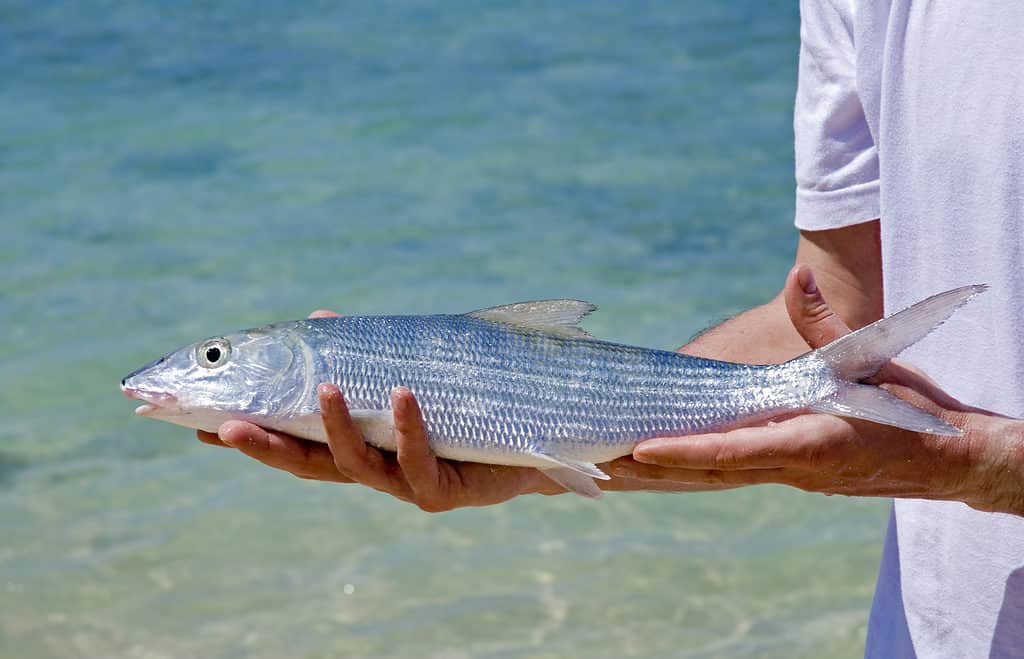Bonefish
Albula vulpes
Bonefish have migratory habits, moving from shallow waters to deeper waters during different times of the year.
Advertisement
Bonefish Facts
- Name Of Young
- Fry
- Fun Fact
- Bonefish have migratory habits, moving from shallow waters to deeper waters during different times of the year.
- Biggest Threat
- Tarpon, barracuda, snook, jacks, and humans
Bonefish Physical Characteristics
- Color
- Blue
- Black
- Green
- Skin Type
- Scales
- Top Speed
- 40 mph
- Age of Sexual Maturity
- 2 years
View all of the Bonefish images!
The bonefish is a saltwater fish commonly found in the shallow waters of the Atlantic Ocean and the Gulf of Mexico. Anglers target this species of fish as they are elusive and, when hooked, put up an intense fight. Bonefish are also commercially harvested for their meat and are considered a delicacy in some cultures. They are often found in sandy, muddy bottoms and feed on small crustaceans and other invertebrates. These fish will grow up to 16-40 inches in length and weigh 8-16 pounds.
Bonefish Fun Facts
- Bonefish have migratory habits, moving from shallow to deeper waters during different times of the year.
- They are also known as grey ghosts due to their camouflaged behavior and fast swimming ability.
- Bonefish are sight-feeders, using their vision to locate food.
- These fish are popular among sport anglers who pursue them using fly fishing techniques.
Bonefish Classification and Scientific Name
This fish species is classified as a marine fish in the family of Albulida. The scientific name is Albula vulpes.
Bonefish Appearance

Bonefish have a shiny, shimmering appearance.
©DUSAN ZIDAR/Shutterstock.com
Bonefish can move through sand and mud to find food thanks to their long, streamlined bodies and flattened undersides. They typically have a shiny, shimmering appearance and light silver color with a greenish or bluish tint. Along with a pair of pectoral and pelvic fins, it has two dorsal and anal fins. The mouth is large, and the head has a flattened look. The most distinctive feature of this fish shows small sharp scales and large protruding eyes.
Distribution, Population, and Habitat
These fish can be found in regions including Florida, the Caribbean, the Gulf of Mexico, Central America, and South America.
Bonefish are highly migratory; their populations can move to different regions based on water temperature, food availability, and other factors. They will move from shallow waters to deeper waters at different times of the year. Some specific habitats for bonefish include mangrove swamps, seagrass beds, coral reefs, and shallow flats.
These fish species require healthy surroundings to thrive; losing mangrove swamps, seagrass beds, and other vital habitats can negatively impact their populations. As a result, conservation efforts have begun in many regions to protect and restore these natural environments. Although data on their population numbers will become limited, data show it’s stable.
Bonefish Prey and Predators
Types of prey bonefish feed on include: shrimp, crabs, clams, oysters, worms, and anchovies. However, predators, including tarpon, barracuda, snook, and humans, prey on bonefish.
These fish have several adaptations that help them avoid predators, including their speed and agility, ability to blend in with their environment, and ability to find refuge in seagrass beds and other habitats. Despite these adaptations, Bonefish will remain vulnerable to predation. The only way to protect and conserve this species is through strict conservation efforts.
Reproduction and Lifespan
This fish species reproduce through spawning, which takes place in the open ocean. However, the exact timing and location of spawning vary on certain factors, including water temperature, food availability, and other environmental conditions.
During spawning, female bonefish release thousands of eggs into the water, fertilized by male bonefish. The eggs hatch into larvae and drift with the ocean currents for several weeks, feeding on tiny plankton and growing rapidly.
As the larvae mature, they move into shallow waters, where they feed and grow. Juvenile bonefish are highly active and agile, and they are capable of quickly escaping from predators. Relatively a fast-growing species, they reach maturity within a few years.
The lifespan of a bonefish is typically around 8-10 years, although some individuals may live for up to 14 years.
Fishing and Cooking
Sports fishermen highly prize bonefish and are widely sought after for their speed, agility, and fighting spirit. Bonefish can be caught using various methods, including fly fishing, spin fishing, and baitcasting. The best method depends on the conditions, the target species, and the angler’s skill level. Various baits and lures can catch these skillful swimming fish, including live bait, artificial flies, and jigs.
Although bonefish are a delicacy, grilling and baking are great ways to cook this delicious fish. The flesh is firm and has a slightly sweet flavor. To enhance the natural flavor of the Bonefish, keep the cooking methods simple. Some popular methods include blackening, sauteing, and steaming with herbs and citrus.
Related Animals
View all 285 animals that start with BBonefish FAQs (Frequently Asked Questions)
Where are bonefish distributed?
The bonefish is widely distributed in the Atlantic and Gulf of Mexico. Some specific regions where bonefish can be found include Florida, the Caribbean, the Gulf of Mexico, Central America, and South America.
Where do bonefish live?
Bonefish can be found include mangrove swamps, seagrass beds, coral reefs, and shallow flats.
How fast can bonefish swim?
Bonefish can swim up to 40 miles per hour.
Thank you for reading! Have some feedback for us? Contact the AZ Animals editorial team.
Sources
- eastend lodge, Available here: https://eastendlodge.com/bonefish-species/
- yellow dog flyfishing, Available here: https://www.yellowdogflyfishing.com/blog/how-to-spot-bonefish-like-a-saltwater-flats-guide/
- take me fishing, Available here: https://www.takemefishing.org/fish-species/bonefish/

















